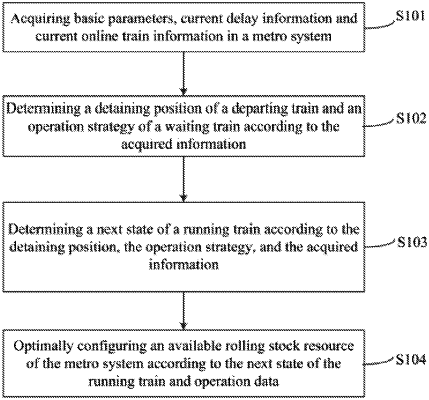| CPC B61L 27/10 (2022.01) | 5 Claims |

|
1. An operation adjustment method for metro trains in a delay scenario, comprising:
acquiring basic parameters, current delay information and current online train information in a metro system, wherein the basic parameters comprise: a topological line structure and operation data; the topological line structure comprises: a line velocity limit, a slope, a position and a siding type of each station, and a position and a switch track siding type of a depot; the operation data comprises: a planned operation diagram, a minimum headway, a position of each backup train and the number of backup trains, and required time for trains to leave the depot and turn back; the delay information comprises: time, a position and duration of delay; and the online operation train information comprises: train services, velocities and positions of all trains upon the occurrence of the delay;
determining a detaining position of a departing train and an operation strategy of a waiting train according to the basic parameters, the current delay information and the current online train information, wherein the operation strategy is a normal departure operation of the waiting train or a departure cancellation operation of the waiting train;
determining a next state of a running train according to the detaining position of the departing train, the operation strategy of the waiting train, the basic parameters, the current delay information and the current online train information;
configuring an available rolling stock resource of the metro system according to the next state of the running train and the operation data;
generating an adjusted operation diagram for the metro trains according to the available rolling stock resource;
transmitting the adjusted operation diagram to the metro trains for operation; and
operating the metro trains according to the adjusted operation diagram,
wherein
determining the detaining position of the departing train and the operation strategy of the waiting train according to the basic parameters, the current delay information and the current online train information, comprises:
determining an affected train set according to the basic parameters, the current delay information and the current online train information, wherein the affected train set comprises a departing train set and a waiting train set;
sequentially traversing the departing train set according to train service numbers in an ascending order, and determining whether a free parking point is present between a current train in the departing train set and a delay occurrence position;
detaining the current train at the free parking point nearest to the delay occurrence position in a condition that the free parking point is present; or detaining the current train at a current position in a condition that the free parking point is not present;
traversing all decision-making combinations in the waiting train set, and calculating a target value under a current decision-making combination, wherein the decision-making combination is a combination of the departure operation and the departure cancellation operation;
determining whether the target value under the current decision-making combination is a current minimum target value;
taking the current decision-making combination as the operation strategy of the waiting train, in a condition that the target value under the current decision-making combination is the current minimum target value; and determining whether all decision-making combinations are traversed, and outputting the operation strategy in a condition that it is determined that all decision-making combinations are traversed; or in a condition that it is determined that all decision-making combinations are not traversed, replacing the current decision-making combination as a next untraversed decision-making combination, and going back to a step of traversing all decision-making combinations in the waiting train set, and calculating the target value under the current decision-making combination;
determining whether all decision-making combinations are traversed, in a condition that the target value under the current decision-making combination is not the current minimum target value, and outputting the current decision-making combination in a condition that it is determined that all decision-making combinations are traversed; or in a condition that it is determined that all decision-making combinations are not traversed, replacing the current decision-making combination as a next untraversed decision-making combination, and going back to the step of traversing all decision-making combinations in the waiting train set, and calculating the target value under the current decision-making combination.
|